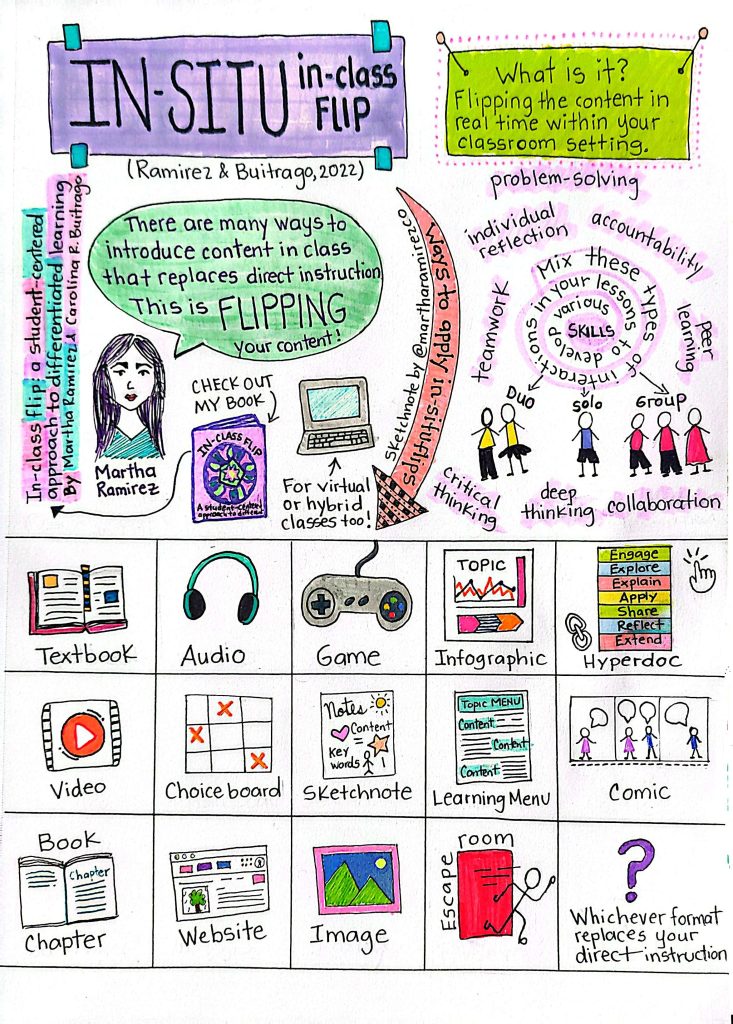Imagine discovering new ways to introduce content in your class in a dynamic, personalized, and student-centered way.
With the In-Situ In-Class Flip approach (Ramírez & Buitrago, 2022), you can take your teaching to the next level, in real time, and inside your own classroom.
What is the In-Class Flip?
When we talk about a flip, this refers to flipping your content directly in class, replacing the traditional lecture with activities that foster:
- Critical thinking
- Collaboration and teamwork
- Responsibility and peer learning
- Problem-solving and individualization
Instead of a teacher’s monologue, your students interact with the content through different multimodal formats, choosing the option that best suits their learning preferences and the lesson’s objectives.
How is it different from an out-of-class flip?
Out-of-class flip: Students access videos, readings, or digital/analog resources beforehand (at home or in their free time). Then, class time is dedicated to exercises, projects, discussions, or application activities.
In-situ in-class flip: Everything happens during class time. The teacher briefly introduces each resource and supports students in real time as they access the content autonomously through the resource provided.
Why choose an In-Situ Flip?
More time for learning and application
The focus shifts from the teacher as the transmitter of knowledge to the students, who spend most of the class exploring, practicing, and applying the content actively and meaningfully.
Immediate teacher support
The teacher accompanies the process in real time—resolving questions, adjusting the level, and providing personalized scaffolding.
Greater equity
All students have access to the class content, without depending on resources, support, or conditions at home, ensuring inclusion and shared understanding.
Flexibility
The format allows you to adapt resources, activities, and levels of depth according to the group’s response and needs at that moment.
Time and pace management
Learning rhythms are better managed, avoiding homework overload, and giving students space to progress in a more balanced way.
With the In-Situ Flip, reflection and practice happen under the teacher’s constant guidance, ensuring a more inclusive experience adapted to the group’s real needs.
14 Options to Flip Your Content

Here are 14 options you can use in your classes to replace direct instruction:
📖 Coursebook: A reading that contains the information you want to teach.
🎧 Audio: Podcasts or clips that present content in an auditory format.
🎮 Game: Educational games that introduce and/or consolidate concepts.
📊 Infographic: A visual synthesis of complex information.
🔗 Hyperdocument: Interactive templates with stages that scaffold learning through hyperlinks.
🎥 Video: Short clips to explain, contextualize, or illustrate.
🎯 Choice board: A menu of learning paths that promotes autonomy.
✍️ Visual note: Visual notes to capture key ideas with drawings and connections.
📋 Learning menu: A thematic menu that organizes tasks by complexity level and offers choice.
📚 Comic: Comic strips that situate content in a visual narrative.
🌐 Website: Microsites with resources, links, and discussion forums.
🖼️ Image: Galleries or collages for visual analysis.
🚪🔑 Escape room: Gamified challenges where each clue requires applying what has been learned.
And the list doesn’t end there! Any format that replaces direct instruction can become an in-class flip.
Deepen and Transform Your Teaching Practice!
If you want to fully discover how to design and apply each of these formats, I invite you to read my book (co-authored with Carolina R. Buitrago), In-Class Flip: A Student-Centered Approach to Differentiated Learning. You’ll find strategies, examples, and templates to design your own in-class flip step by step.
👉 Get your copy today and start flipping your content with creativity and effectiveness.
Click here for more information.
Para leer este artículo en español haz clic aquí .